Perry and Whitford Gear Post-Toys Live (1975) and Beyond
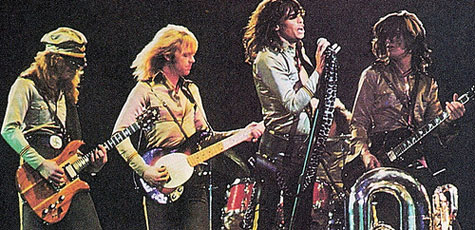
The boys, flanked by BC Riches, 1978.
It’s tough to pin down the Aerosmith guys as far as what guitars were used when because they definitely didn’t stick with any one instrument too long, even during any given concert. But amp-wise, after Toys they switched over to the new-at-the-time Music Man amps which had 6L6 power tubes (like Fenders) but solid-state preamps.
It seems Aerosmith started using these amps live in September 1975, but they were not stock. In a March 1979 Guitar Player interview – conducted after the Live Bootleg album was out (1978) which covered the Draw the Line tour (1977) – Joe Perry said:
“I’m not sure what model [Music Man heads] I use but we got the first prototypes about three years ago. In fact, I remember coming out of rehearsals for Toys In The Attic, and we went out on the road and got the Music Man amps then. We’ve been reworking them until now.
“We’ve put a graphic equalizer in the midrange and we have something that will change the amount of top end you want – it’s like a different way of looking at a midrange control. And all the guitars are set up to go in at line level – they all have cannon [balance line] plugs, so you can have 100-foot cords and there’s no noise, none of that radio frequency interference you get with a regular patch cord, although I can plug in with a patch cord if I want. The Grateful Dead used to do it but I don’t know of anybody else who does.
“I’ve had only five or six amp failures in the whole time I’ve used Music Mans – tell that to your Marshalls as they go up in smoke!”
At that time, he said he was playing the heads through stock Marshall cabs, but had been using cabs with JBLs. “I’m currently using Marshall cabinets – just straight Marshalls – and I’m throwing out the JBLs. I’ve been looking for a change. The JBLs are real clean, but I’ve been using them for a while. So what I’m going to do is plant a bunch of Marshall cabinets all over the stage, as well as two stacks in back of me, and have an amp running them all.”
He added: “The way I have it now, one master amp is set up in the back, so all I have to do is plug into the right places, and one preamp will control all of the output amps. And I can slave them out like that, so one control can handle all the monitors and everything.”
Here’s how he set the Music Mans: “The master volume is always on full, and I’ll change the channel volume depending on the guitar. If I have a B.C. Rich, I can turn it down. But if I have a Fender [Strat], I have to turn it up. That’s basically it. It wouldn’t mean anything to tell you how I have the midrange adjusted because it’s a custom setup, but I put the bass and treble at two o’clock. I take both of those switches off, although sometimes I’ll leave the treble switch up, depending on my mood.”
Here’s some info on Brad Whitford’s post-Toys gear from the article mentioned in the previous WoodyTone post on Aerosmith:
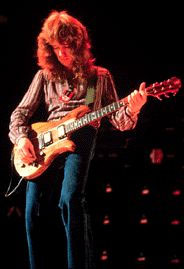 He replaced the Ampegs (V-4s) with…Music Man amplifiers. The interiors were altered – the exact mods escape him – but with the change, Brad believes, the amps now are virtually indestructible: “You could play them for a week and they wouldn’t blow up.†Brad had the amps modified because, in their original, off-the-showroom floor condition, “They had a tendency to diminish treble response when the bass boost was on. The bass boost now adds bass without detracting any from the other ranges.â€
He replaced the Ampegs (V-4s) with…Music Man amplifiers. The interiors were altered – the exact mods escape him – but with the change, Brad believes, the amps now are virtually indestructible: “You could play them for a week and they wouldn’t blow up.†Brad had the amps modified because, in their original, off-the-showroom floor condition, “They had a tendency to diminish treble response when the bass boost was on. The bass boost now adds bass without detracting any from the other ranges.â€
Depending on the venue, he uses one or two Music Man tops running through four custom-made cabinets similar to Marshall except they are ported and use JBL speakers. He may soon switch to Celestion speakers, however, because he feels that the JBLs are “so damn clean that they are actually too efficient for stage work.â€
Live, the guitar arrangements include two B.C. Rich Eagles (one is a spare); a Rich Bich modified by removing four of the ten strings; and a new Les Paul Custom with Bill Lawrence L-90 XL pickups.
The guitars run through a rather elaborate set of pedals labeled “toyboxes†by the band. There are two sets of pedals; one resides in the middle of the stage and the second board sits off to one side. They include an AKG reverb unit, a number of MXR effects including a 10-band EQ, flanger, phaser, compressor, and a DDL [digital delay] with three presets.
> Apparently the BC Rich guitars – Brad and Joe both used them – showed up after Rocks.
> I also have in my notes that Joe, and possibly Brad, also used an Eventide Harmonizer live.
More on Joe’s Guitars
From the same GP interview:
What guitars are you using currently?
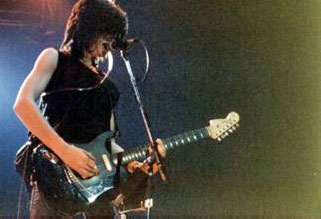 I use a Fender Stratocaster a new, left-handed one–a couple of B.C. Rich guitars, a’65 Fender Telecaster, and a couple of Dan Armstrongs. Actually, I have three B.C. Rich guitars although I only use two, and I have three Strats onstage, with two of them as spares. Because I use a lot of different tunings, I have different guitars for different songs. Sometimes I use more, sometimes less. I have to have about 15 guitars on the road, just so I can have a spare for whatever combination of songs we want to do. And I need at least three Stratocasters, because they’ll eat strings for no reason. I break strings left and right, and sometimes I have to break the guitars in – and the next day, they have to be glued back together. All Stratocasters require a short breaking-in period, generally, a good whack against the side of an amp in a fit of rage takes care of it.
I use a Fender Stratocaster a new, left-handed one–a couple of B.C. Rich guitars, a’65 Fender Telecaster, and a couple of Dan Armstrongs. Actually, I have three B.C. Rich guitars although I only use two, and I have three Strats onstage, with two of them as spares. Because I use a lot of different tunings, I have different guitars for different songs. Sometimes I use more, sometimes less. I have to have about 15 guitars on the road, just so I can have a spare for whatever combination of songs we want to do. And I need at least three Stratocasters, because they’ll eat strings for no reason. I break strings left and right, and sometimes I have to break the guitars in – and the next day, they have to be glued back together. All Stratocasters require a short breaking-in period, generally, a good whack against the side of an amp in a fit of rage takes care of it.
Why do you use a left-handed Stratocaster?
It sounds different and feels different to me. It’s just a subtle difference. And I know the way the pickups are set in there, and the way the tension on the arm is, and the length from the nut to the tuning pegs are all different–so it has to add up to something. It’s the most comfortable guitar for me, and it stays in tune better. The only reason I play it is for the vibrato arm, and the Strat has a certain unique tone.
Is that something you came across on your own?
Well, Jimi Hendrix did it, so you learn from the master. It worked for him. Bill Lawrence, who is our consultant now, never recommended a left-handed Strat, but I figured I’d give it a try. Plus, it looks really good – I like the way it looks upside down.
Have you modified it in any way?
Yes, a great deal. Stratocasters have never been satisfactory to me – the old ones are either too good or just visibly fall apart on the road. But they don’t stay in tune, and the new ones do stay in tune. So we started from there and worked on it every night: When I say we, I’m talking about me and Neal Thompson, who takes care of all the guitars…. The guitar has been shielded with this copper or aluminum paint, and we changed the electronics by putting Bill Lawrence L-220 pickups in. We re balanced the neck and removed the neck’s back plate, putting four screws in there to balance it. And we did a few other tricks with the vibrato arm that I’m not going to mention. If you put this guitar up against a stock Stratocaster, you wouldn’t be able to play both of them using the same amp, because the signal-to-noise ratio would be so bad in the stock guitar. My Strat is as quiet as a guitar with a humbucking pickup. And I also put a brass nut on it, although the tuning heads are still stock, mainly because I haven’t found any others I like better.
What else is there about the left-handed Stratocaster that you like?
Well, one thing you have to avoid is trying to play real high, because you just can’t get up there. With a little practice you know where to go, but you don’t go for the real high notes. That’s why Hendrix had an octave machine, I think. It’s weird because the tension is totally opposite – the low E string, instead of being the shortest, is now the longest, and the high E is now the shortest. Also, the angle of the strings over the pickups is different, and that has to do something. Every once in a while you’ll hit the tone control because it’s right below your hand.
Do you like the Stratocasters with maple necks?
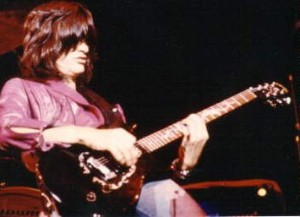
This mystery guitar apparently is a refinished and inlaid Les Paul Junior.
Yes, I like those better. They’re hard guitars to play. The new ones are undeniably stiff and hard to work around, but the advantage of the sound and the vibrato arm is worth the effort: Once you start and get into it, you forget about it in two seconds, And then I go and pick up a B.C. Rich Bich, and it’s like wearing weights when you’re running and then you take them off.
What Rich guitars do you use?
Well, right now I’m using a Bich, which is the 10-string guitar. Brad Whitford has a blue one, and I have a red one. I got it about four months ago, and I took the extra four high strings off. The guitar, played that way, felt so good and sounded so good that it seemed ridiculous to have extra strings there. I might put those extra strings on for the studio, but right now the thing screams.
So the B.C. Rich and the Stratocaster are your main stage guitars?
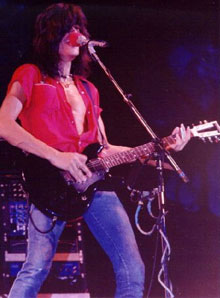
Slidin' not on a Dano but on a Travis Bean.
Yes. And for different tunings, I have Dan Armstrongs. I use them for slide – I really like them for that. And those guitars have been changed. All the guitars I own have been reworked – all the pickups have been changed. That’s how you can avoid paying more than $500 for a guitar. I have paid $700 for a new Strat, but that was out in the sticks when I needed one. Everything is going up, and I know I’m going to have to start paying more.
Like those B.C. Rich guitars: I did pay for the first couple, because I didn’t want to endorse anybody until I really liked their product. And so finally I did endorse B.C. Rich, and he gave me a solid rosewood Mockingbird. It’s an amazing guitar. It’s so heavy! I did “Come Together” [Sgt. Pepper’s Lonely Hearts Club Band movie soundtrack] with it, which was live, and I used it for “Milk Cow Blues” [Draw The Line], which is also live in the studio, so you can get an idea. But onstage it’s one step louder than everything else, so it almost has too much presence. And for that reason, I don’t use it that much onstage.
In the Studio
Since Joe said he and Brad had been fooling with the Music Man amps for 3 years, that may mean that they were used on Rocks (1976) and Draw the Line (1977). I couldn’t find anything or anyone who could say for sure, but Joe did say this in the 1979 interview:
“When I’m at the Record Plant in New York City, I use some Ampegs they have there – really hot Ampegs that sound a lot like Fender Dual Showmans. The Ampegs are new ones, but they’ve been reworked. I also use whatever I can get my hands on. I have a bunch of old amps myself that I keep in my basement – I also have a studio there. What we do is set up a wall of all the different kinds of amps we want and then see which ones sound good. Even in the middle of a song I’ll change amps, just to change it around.”
That sounds like what the guys do to this day!
Guitar-wise in the studio, Joe said he had “lately” been digging the B.C. Rich Bich. “I used a Tele in ‘Draw the Line’ for slide because I didn’t have any Dan Armstrongs at the time.” He added: “I used the Rich Bich on ‘I Wanna Know Why’ [Draw The Line], but I like to use Strats for leads, mostly because I like the vibrato arm.”
Notable: Pickups
This is according to user wingwalker on thegearpage.net, the Bill Lawrence pickups Joe and Brad used were: “L-220 single-coils (which are not true single-coils) and L-90 buckers. I looked and looked and looked for a set of each, and they simply nail those old Aerosmith tones. The L-90s are quite nice. These are the pickups Bill was making before the L-500 series but they are a world apart.”
Toys in the Attic, Live 1978, Texas Jam
Category: Ampeg, BC Rich, Bill Lawrence, Brad Whitford, JBL speakers, Joe Perry, Marshall, Music Man, MXR, Strat













